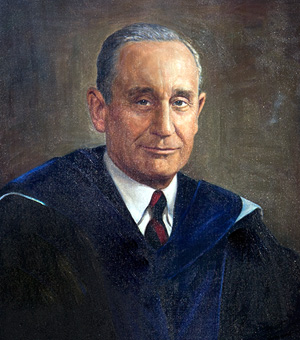Lewis Webster Jones
Rutgers President, 1951 to 1958

Lewis Webster Jones (1899–1975), of Emerson, Nebraska, was a noted economist and university president, a man of deep insight and broad educational philosophy. He spent his boyhood and youth near Portland, Oregon. A graduate of Reed College and the Brookings Graduate School of Economics and Government, where he received his Ph.D. in 1927, he had undertaken postdoctoral studies at Columbia University, the London School of Economics, Cambridge, and Geneva before serving as an economist and editor with the Foreign Policy Association until 1930. During his stay in Europe, he served as an economist on the staff of the League of Nations. For two years he was the economist for the Committee on the Costs of Medical Care and then joined the original faculty of Bennington College in 1932. In 1941 he was named president of Bennington, serving with distinction until 1947, at which time he became president of the University of Arkansas. During his presidency at Arkansas, Jones was a member of the President’s Commission on Higher Education. On September 7, 1951, he was selected as the 15th president of Rutgers.
Under Lewis Webster Jones, Rutgers began to fulfill its pledge to serve the state of New Jersey. Most significant was the reorganization of the university’s governing structure. In 1956 the Board of Governors was created to provide the State with a larger role in the control of the university. Recommended by a special committee of the Board of Trustees, the Board of Governors consisted of 11 voting members, six appointed by the governor and five from among the trustees, which continued to exist to serve in an advisory capacity, to manage certain funds, and to act as a “watchdog” over educational standards.
A noted economist, Lewis Webster Jones was devoted to redefining the relationship of Rutgers and the State of New Jersey and to expanding the university to meet the increase of students seeking higher education.
A major building program resulted in the construction of Alexander Library, the River dormitories along the Raritan (named after past presidents Frelinghuysen, Hardenbergh, and Campbell), the completion of Demarest Hall on the College Avenue Campus, Lipman Hall at the College of Agriculture, and Waksman Hall, which houses the Institute of Microbiology on the Busch Campus. Other construction projects under way or in the planning stages at the time of his departure in 1958 included new buildings for the study of horticulture and poultry on the G.H. Cook Campus, a library at Camden, and a health center and two new dormitories at the College for Women, renamed Douglass College in April 1955 in recognition of the vision and leadership of its first dean, Mabel Smith Douglass.
With expansion of facilities came an increased emphasis on graduate education. In 1954 Rutgers established two new divisions: the Graduate School of Social Work and the Graduate School of Library Service. Through the generous bequest of Florence Eagleton, the Eagleton Institute of Politics was established. By 1957 nearly 1,000 students were enrolled in graduate programs throughout the university. Educational programs and facilities were also expanded in Newark and Camden. A nursing curricula was introduced on the Newark campus in 1952 and evolved into the College of Nursing four years later. Scientific instruction and facilities received increased federal support after 1957 in the wake of the Soviet Union’s launching of Sputnik.
Lewis Webster Jones resigned as president of Rutgers in August 1958 to accept the presidency of the National Conference of Christians and Jews. In 1965 he retired to Sarasota, Florida, where he lived until his death on September 10, 1975.

